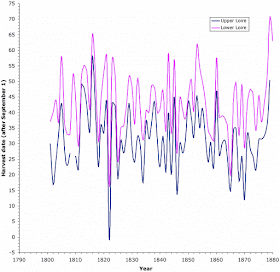I have written a number of times in this blog about the strong tendency for people to present reticulating evolutionary relationships as trees rather than as networks. This involves them somehow reducing complex networks to bifurcating trees.
When referring to a "family tree", the most common way to reduce a network to a tree is simply to repeat people's names as often as necessary. That is, rather than have them appear once (representing their birth) with multiple reticulating connections representing their reproductive relationships, they appear repeatedly, once for their birth and once for each relationship, so that there are no reticulations. I presented a number of online examples of this process in my posts on Reducing networks to trees and on Thoroughbred horses and reticulate pedigrees.
Recently, Jean-Baptiste Piggin has pointed out that this approach actually has a very long history, indeed, actually dating back to what seems to be the first pictorial representation of a genealogy.
In an earlier post (The first infographic was a genealogy) I described Piggin's work on what he calls the Great Stemma, a diagram from c. 400 CE (Late Antiquity) representing the genealogy of Jesus as presented in the New Testament. In a recent update, Piggin reports:
The Great Stemma contains 13 doppelganger or fetches, that is to say, simultaneous appearances of the same person in two places, e.g. Hezron [as a] child, and separately as an ancestor of Jesus. This graphic method simplifies the layout, but forced the Late Antiquity reader to mentally register these virtual "hyperlinks".If you view his diagram of the Great Stemma (Touring the Reconstruction), you can see on an overlay a set of links connecting the multiple appearances of the following people:
Athaliah, Gershon, Hezron, Judah, Kohath, Leah, Levi, Mahalath, Merari, Perez, Rachel, Rebekah, and Timna.
This repetition simplifies what is a rather complex diagram, which actually shows a network of family relationships. There is still one reticulation in the diagram, however, because it depicts Jesus' ancestry as described in the New Testament by both Matthew (labeled Filum C in the schematic below) and Luke (labeled Filum D), and these differ regarding the descendants of David (but not his ancestors).
The diagram contains more than just a genealogy (represented by Filum A-D), as it also displays other references from the Bible (indicated in yellow). Piggin is still working on his reconstruction (there are no known copies of the original, only later hand copies), and he continues to make discoveries.
Of especial interest in the genealogies is that Piggin now reconstructs the Great Stemma as having a strictly grid-like arrangement of the people, as discussed in his blog post Secret of the oldest infographic revealed: a grid. The placements of the lineages in the Stemma, and the connections between the people, are not always obvious to modern eyes (see my post on How confusing were the first written genealogies?), since we are used to the modern version of a "family tree" — it took another millenium after the Stemma to settle on the modern version. However, the use of a regular grid-like arrangement in the Stemma seems surprisingly modern by comparison.
Unfortunately, this arrangement seems to have become corrupted in the subsequent hand-made copies, suggesting that the scribes did not always appreciate the grid's organizational importance.








